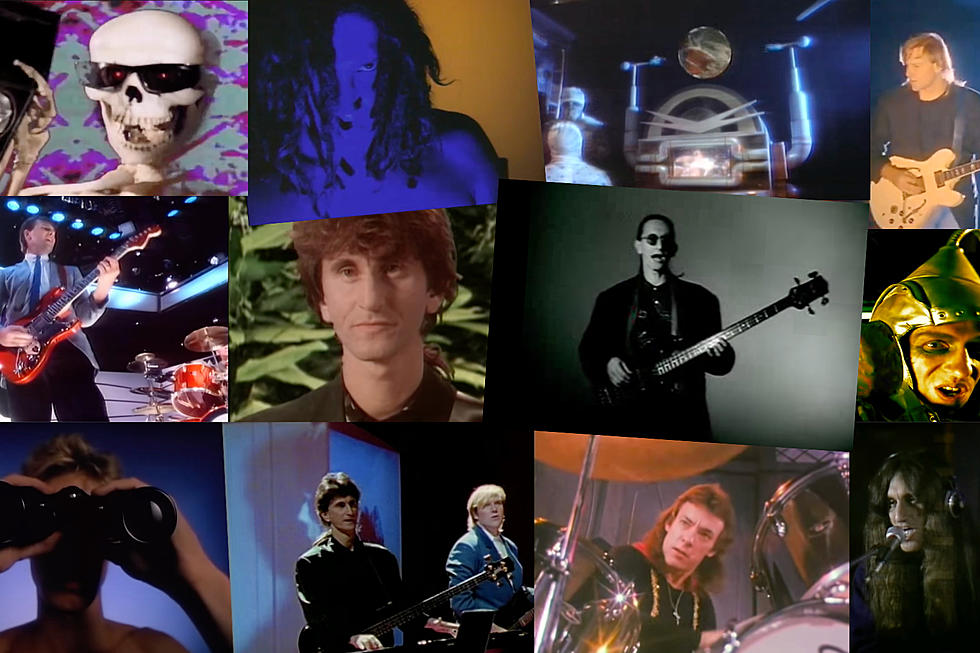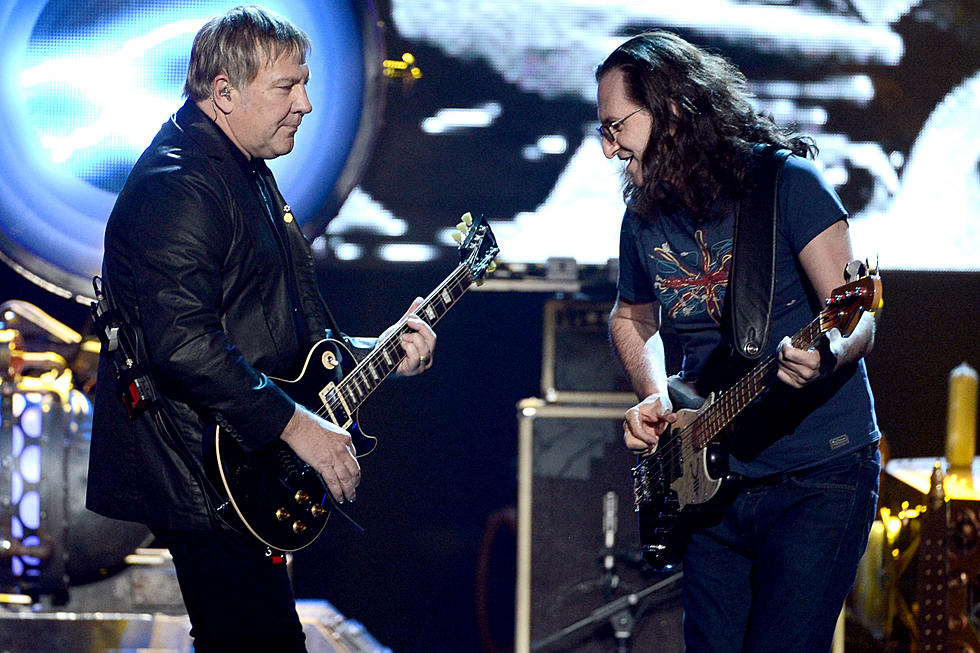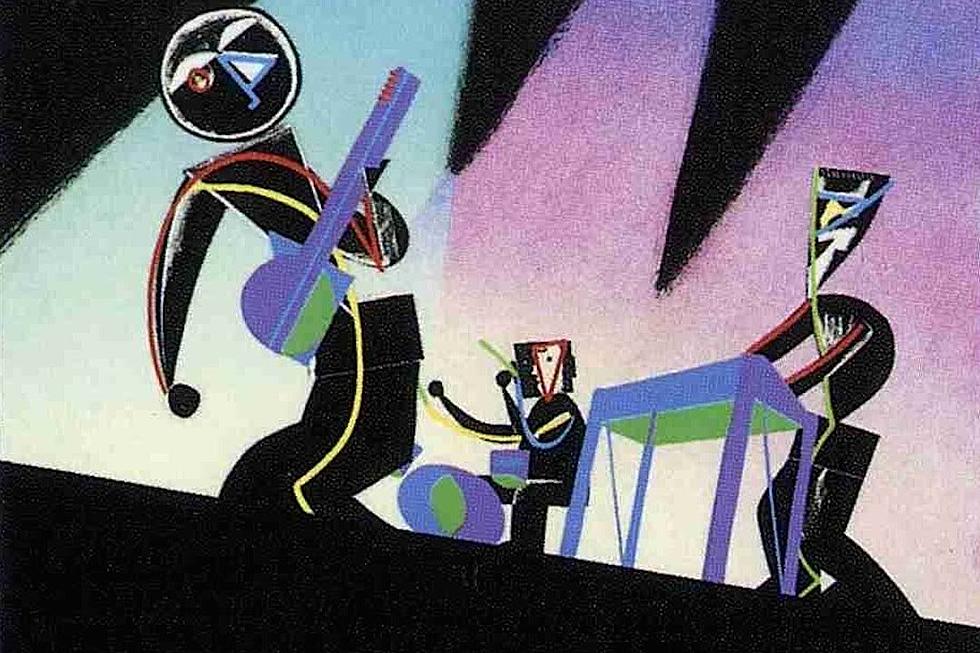
All 31 Rush Videos Ranked Worst to Best
"So much style without substance / So much stuff without style," Rush's Geddy Lee sings on "Grand Designs," channeling drummer Neil Peart's rejection of cheap consumerism in pursuit of true art. "Swimming against the stream," he observes later. "Life in two dimensions is a mass production scheme."
Fittingly, the prog-rock trio never bowed to the altar of MTV, arguably the biggest mass production scheme in music history. But as major recording artists of over four decades, they also couldn't avoid the music video as a promotional tactic — even if they never quite landed on a consistent visual vibe of their own. (Unless you count their super goofy stage videos, but that's another story altogether.)
It was all secondary anyway — their songs did the talking for them, and no flashy clip could have sold a non-fan on the intricacies of "Subdivisions." But it's still interesting to look back at the randomness of Rush's videography: a grab-bag of straightforward stage renditions, Big Message Symbolism and (for a brief time) Even Bigger Haircuts.
Given that piecemeal quality, it's awkward ranking all the Rush videos. How can we really compare a "live" version of, say, "A Farewell to Kings" to the in-studio scenes of "Tom Sawyer" or the dated, effects-loaded campiness of "Time Stand Still"? But we're up for the task. (For the sake of simplicity, we're not counting any lyric videos, repurposed concert film excerpts or semi-official clips.)
There's no Natural Science here — only what feels right. And with that in mind, we present All 31 Rush Videos Ranked Worst to Best.
31. "Roll the Bones"
It’s only fitting that Rush paired their cringiest song with their cringiest video. Like “Roll the Bones” itself, the visual strikes a bizarre balance of profundity and stupidity, using the album cover’s dice backdrop as a springboard into themes of chance, carpe diem conviction and … wait, is that a rapping, mohawked skeleton? You can’t blame Rush for showing their playful side, but just like Lee’s pitch-shifted foray into hip-hop, this clip feels beneath them.
30. "Superconductor"
The “Superconductor” video almost transcends its cheesiness. Almost. Building on Peart’s lyrics on consumerism and mass media deception, the clip cuts back and forth between a faux Rush show and a variety of flashy performers, including dancers and sword-swallowers. The fist-pumping audience goes wild! And turns out, as the camera reveals by panning upward, that an evil, suit-clad businessman is orchestrating their emotions through some kind of mixing board. Snooze. The only redeeming elements are Lee wearing a leather jacket and Alex Lifeson miming the low “superconductor” backing vocal.
29. "Time Stand Still"
“Freeze this moment a little bit longer,” Lee sings — just maybe not for the video. Then again, should this be No. 1? It’s certainly the band’s most memorable video — in that it’s hard to forget you watched it, no matter how hard you try. Corniness reigns supreme: The band members float around the frame with some kind of green-screen trickery, even briefly appearing above a scenic creek; Lee and Lifeson, both at their peak of ‘80s fashion flashiness, even employ some choreographed spins during the chorus. Looking back, Lee remains good-natured about the whole thing: "This is my hair at its worst,” he told Rolling Stone. “It’s a bad 'do. I don't even think we ever really nailed music videos. The funny thing is just watching this giant drum kit flying through the air. It's one thing to see humans. They have a form. But here's this whole drum kit floating through space. Who says we don't have a sense of humor?”
28. "Show Don't Tell"
In which a teenager is bombarded by bummer headlines, staring blankly at a newspaper and letting TV reports wash over him. The video is about as fun as it sounds. But at least we have some kinetic shots of the band, with Lee playing the bejesus out of his Fender Jazz bass.
27. "Nobody's Hero"
Presented partly in black and white, this video appears to explore mass culture’s broad definition of “hero”: teachers, professional athletes, astronauts, the “glamour girl” posing as the cameras flash. At one point, a janitor finds a dollar bill on the ground and calmly sticks it in his pocket. Pretty much everyone is wearing a black mask. Rush play their instruments in color. Nothing much to see here.
26. "Countdown"
Lifeson channels his inner Pete Townshend with some resounding, windmill-like guitar moves; Peart calmly keeps time; Lee stares intensely into the camera eye, like he’s trying to cast a spell on it. The rest is pretty straightforward, following the lyrics with shots of a space launch and cheering, awe-struck crowds.
25. "The Body Electric"
We open with some kind of futuristic factory accident involving a worker who looks like he could’ve been a Whitesnake roadie. From there, we cut to the same hazmat suit people from the “Enemy Within” video (see below), but it’s hard to really make out much of a concrete plot. All we know is our protagonist did something very bad, and he’s being pursued by evil bosses in this vague dystopia.
24. "Distant Early Warning"
The musicians peer through the darkness, later playing their instruments on what appears to be an alien ship. A boy makes sand castles in his front yard and eventually rides away on a missile, gripping tight as a green-screen montage helps him soar over mountains and rivers and cityscapes. The clincher: Lifeson and Lee join each other in a playful stare-down. So bad it’s good? You decide.
23. "Malignant Narcissism"
This band-approved clip, created by animation expert Bobby Standridge, follows the “family tree” of world religions, with each branch — “Ancient,” “Eastern” and “Western” — slithering like serpents into a twisted tapestry. There are no words to draw from on this Grammy-winning instrumental, but the visuals still tap into Peart’s philosophical themes from Snakes & Arrows.
22. "Anthem"
Our trio may play in front of a castle-like backdrop, but the energy is more befitting a dank, dingy rock club. Everyone contributes stand-out moments, including Lifeson’s many orgasmic guitar faces. But Peart is the MVP, based on his strange look alone: mullet-like haircut, cross necklace and frilly court jester vest. Bonus points for the moment at 1:36, when he completes a flurry of crashes on only one cymbal. (It’s almost adorable how modest his drum kit looks compared to the gargantuan display of his later setup.)
21. "Closer to the Heart"
Most of Rush’s late-'70s videos have a simple premise: Put the band on a stage, point a camera at them and ask them to play. “Closer to the Heart” basically follows that model, with a few artsy adjustments: We open with Lee’s eyes piercing through a circular frame, surrounded by the faces of world leaders; the camera work is a little more lively throughout; and we can briefly see the heads of audience members, suggesting a TV studio-type set-up. (Was this one mimed? If so, they’re doing an impressive job of it. But even if Lifeson’s a god, he can’t simultaneously play two harmonized guitar parts.)
20. "Circumstances"
We could have easily declared a tie for all the videos from this period: It’s hard to differentiate between them. This one’s probably the most by-the-books, but there’s plenty to enjoy anyway. Highlights include Lee’s stellar lean-back bass moves, and the instrument hopping of the glockenspiel/synth section.
19. "The Trees"
To kick things off, we gaze out at — you’ll never guess it — some trees! Brilliant. And from there, this symbolic fairy tale of “unrest in the forest” is paired with a familiar stage visual, showing Rush at their peak of shagginess and showiness. Nice touch ending with a creepy shot of a blood-red sky.
18. "Xanadu"
No one has ever banged the tubular bells with more mustachioed ‘70s prog intensity than Peart in the “Xanadu” video. He really gets to flaunt his non-drumming skills, functioning as a one-man percussion orchestra. His bandmates, decked out in flowing robes, aren’t too shabby themselves. And nothing beats Lee’s intense croon-y face on the chorus, wringing out maximum theatricality from each syllable of the word “Xanadu.”
17. "Vital Signs"
Rush continued their budget-friendly video approach for the Moving Pictures cycle, filming a trio of clips in Quebec's Le Studio, where they tracked a handful of albums over the years. Just like with the late '70s stage stuff, it's hard to rank one over another. "Vital Signs" is probably the silliest and most dated, incorporating some '80s-centric effects and the pulses of an electronic waveform. At one point, all three members goof off while wearing sunglasses, seemingly riffing on the thought, "What would an ultra-cool rock star do?"
16. "Tom Sawyer"
So many fun details in this one, like the prominent shot of an Eraserhead poster on the wall and glorious snow outside the enormous studio windows. But Lee’s presence dominates: Decked out in a pair of sharp glasses, he alternates between tracking Rickenbacker bass, synthesizer and vocals (the latter while occasionally resting his hands on some bongos).
15. "Limelight"
A German Shepherd runs off into the distance, and we zoom in on Le Studio, where Rush are recording this Moving Pictures staple. Lee features prominently once again: singing while clutching his headphones, laying down a nasty bass line on his Fender Jazz. The one wrinkle here is looking backward, interspersing studio shots with random '70s stage footage.
14. "Fly by Night"
“Fly by Night” and “Anthem” are almost identical in execution — given that they utilize the same stage backdrop and outfits, we can only assume they were filmed back to back. We’re giving this one the edge because of Peart’s mean-mug drum face and nifty stick spins. That guy was a virtuoso of technique — but also flair!
13. "Afterimage"
“Afterimage” is a dark, poignant piece, with Peart’s lyrics (“Suddenly, you were gone / From all the lives you left your mark upon”) channeling his grief over Robbie Whelan, the Grace Under Pressure assistant engineer who died in a 1983 car accident. The video offers an appropriate intensity: Lee staring mesmerized into the camera from behind his keys, Lifeson wailing on his guitar, a crowd of centuries-old mourners staring at the dead body of a woman in the street.
12. "The Big Money"
Like “Time Stand Still,” the “Big Money” clip is deliriously ‘80s — all dated effects and hokey backdrops. But this one offers an intensity and conceptual focus that the other lacks, with Rush nodding to the Power Windows artwork (hey, there’s the teenage character from the album cover!) within a digital cityscape that recalls Dire Straits’ “Money for Nothing.” Still, though, it’s the little things: Lee’s awkward, bent-leg bass stance and random air finger-drumming, Peart unsheathing an adorable grin after a successful stick toss.
11. "Far Cry"
Before linking up with Rush, director Christopher Mills worked with indie-rock bands like Interpol and Broken Social Scene. Fittingly, he brings a more hip, modern touch to the “Far Cry” video, blending stop-motion surrealism and left-field experimentation. Within, a man in a wig and sunglasses sits at a desk, swallows what appears to be a pill, removes a pair of gloves and creates a multi-media shrine to the prog band themselves, including nods to decades-old clips.
10. "Stick It Out"
Rush embraced grunge’s abrasive edge on 1993’s Counterparts. So, it's no surprise that their menacing “Stick It Out” clip could be easily mistaken for, like, Soundgarden. A man tied to a chair breaks free of his restraints; later, he’s tied up again, dangling from a rooftop above a city. He falls, floats through the air and lands in water. Meanwhile, Rush play in a stormy outdoor scene that looks like it was guest-directed by David Lynch. What exactly is happening here? As Will Ferrell once proclaimed in the 2007 film comedy Blades of Glory, “No one knows what it means, but it’s provocative!”
9. "Half the World"
“Half the world hates / what half the world does every day,” Lee sings on this crunchy Test for Echo single. And Rush demonstrate this societal divide throughout this kaleidoscopic clip, anchored on shots of various fictionalized protests. Elsewhere, there’s plenty of symbolism and surreal flourishes: a severed finger, nuclear explosions, glimpses of Egyptian pyramids, band footage sped up and crackled like a silent film. And it’s all rounded out with stylish, sepia-toned shots of the trio playing in back yard.
8. "Lock and Key"
A perfect balance of Easter eggs, symbolism and eerie atmosphere, “Lock and Key” is unlike any other clip in the Rush catalog. A cigar-chomping businessman juggles some red balls on the street, In an overt reference to the Hold Your Fire gatefold art. Meanwhile, Rush play the song in front of large screens flashing scenes from the 1932 crime-drama film The Last Mile.
7. "A Farewell to Kings"
Now this is maximum bang for the buck, decorating stage footage with some artfully shot scenes. The first minute of “A Farewell to Kings” is exquisite: the swimming swans; the decollate pan across the outside of an old castle; the hazy, voyeuristic opening of Lifeson playing nylon-string guitar in the weeds. A puff of smoke segues into the performance, and it’s all smooth sailing from there.
6. "La Villa Strangiato"
“La Villa Strangiato” is the pinnacle of their stripped-down “live-performance-as-promo” series — with a song full of so many stylistic twists, it’s best just to keep things tidy and let Rush be Rush. It’s geeky fun to watch Lifeson’s glorious volume swells and Lee’s switch from bass to synth. If only they’d utilized a dedicated Peart mustache cam.
5. "Subdivisions"
The dreamer and the misfit are so alone indeed. Our protagonist roams the “high school halls,” navigating through the jocks and cool kids before heading home to watch Rush on TV. It could come off as Lifetime movie fluff, but (cheesy graphics aside) the sentiment of teenage angst is handled delicately here, these scattered scenes amplifying the song’s rich themes. A bowtie-clad Lifeson adds some lightness, humorously miming the song title into the mic with a blank look on his face.
4. "Driven"
Years before he helmed the 2016 Rush documentary Time Stand Still and worked as the band’s tour art director, Dale Heslip brought this heavy tune to life. His jittery camera follows a pair of goggle-wearing, weirdly costumed guys as they race on comical little motorbikes around an old hydroelectric plant in Toronto. (At one point, an old-timey gas station employee fills up one of their mouths with gasoline. Now that’s full service!) “You can see a lot of the stuff that was in the Clockwork Angels tour; you can see a lot of the same influences,” Lee told Rolling Stone. “A lot of the steampunk. ... It was a lot of fun to do. Dale is a kind of quirky and brilliant art director. You can see that at work here.”
3. "The Enemy Within"
We zoom in and out on the musicians’ eyes. A spider crawls. Lee offers a shifty glance at the camera. A sci-fi jukebox drops a digital needle, as the band starts to play in a dark room. People wearing hazmat-style suits break out into a fight. A creepy-looking mask appears out of nowhere and becomes stop-motion animated as it shifts from black to white. Listen, your guess is as good as ours. But the imagery perfectly matches the song’s frantic, futuristic mood.
2. "The Pass"
Lost souls are a recurring theme in the Rush catalog, and never more affecting than with “The Pass,” the band’s biggest tearjerker. The song documents the tragedy of suicide — an already-difficult subject that didn’t need complicating. And this black-and-white, smoke-smeared video wisely keeps things simple, following a teenager at a moment of crisis. These scenes say a lot with little, as does Peart’s solemn stare from behind the kit around the 4:12 mark.
1. "Mystic Rhythms"
Devo’s Gerald Casale directed this eye-popping piece, which unfolds with a sort of dream logic. None of the images are grounded in reality, but it’s hard not to embed meaning into all of them. There’s so much to savor: Peart playing on a rotating drum platform, a bug twitching in tree branches, a skeleton filled with human dolls, Lee singing in front of scrolling green screen foliage, Lifeson and Lee gazing into a glowing orb. You almost never see “Mystic Rhythms” on “best music video” lists, which could be the biggest mystery of all.
Top 50 Progressive Rock Artists
The Rush / Metallica Team-Up That Slipped Away
More From Ultimate Classic Rock









